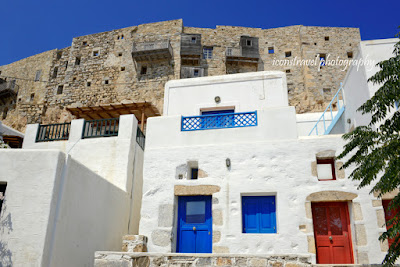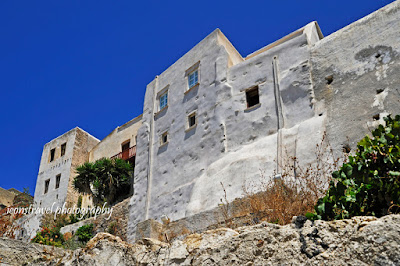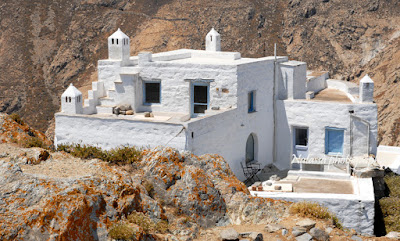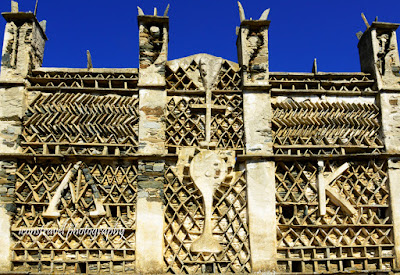text - images, κείμενο - φωτογραφίες: Babis Pavlopoulos, iconstravel photography
language, γλώσσα: English, Ελληνικά
My previous
large book, “Towers & Fortified residences in the Peloponnese, 15th-19th
Century” was an almost 8 years work, until its publication in 2008. For all
these years I used to spend my free time searching everything about my subject
in books, traveling, trying to locate the objects of my study, and certainly
writing, so after the publication it was very hard to me accepting that the
only thing I had to do was to flick through my already published book. So, very
soon I realized that I had to find a new project to work on, a project that
could touch me as much as my previous book. I started different subjects that
had to do with old building categories and trends of traditional architecture,
but at the end of the day I decided to work on architectural complex-sets.
However, in the process I discovered that I had already started dealing with
the issue a long time before I consciously decided it.
Then, I
found myself travelling in the Aegean Sea once again. Fortunately I realized
that the circumstances were much better with the boats than back in the 80s, as
if I had to work on this subject, I would make many travels to the Aegean
islands. I dug up my analogic photo archive, I moved my half book store next to
my desk, I planned the travels, and I searched for books that I would need and
I had not bought yet. It is worth noting that we are talking about the years
2011-12 onwards, so surfing on internet had its own role to my research.
Nevertheless, the first words were written in Mani on a paper as real manuscript.
However, if you like to write about collective defense in Greece without
referring to Mani, it is better to go for fishing.
In this
way, rather slow, we began traveling, taking photos, noting everything, and
finding search material, until… the pandemic came. They close us inside our
houses, our jobs were ruined, so we had to find out something creative to keep
our mind. Writing a book looked an amazing perspective. We had just to ride the photos, the bibliography, and
the memories we had from each place we visited, and the trip was ready.
However, we had already made all the trips we had to do, the material we need
had been concentrated, while our thoughts had already begun imprinting on the
paper and on the computer.
The book
began in Greek, while perhaps I had never believed that it would really finish,
as it seemed almost impossible to find the free time that this effort would
need. In addition it was also almost impossible to find the way to publish it.
It would be an expensive publication of rather limited interest, during a tough
period. Nevertheless, these thoughts were the starting point for turning my
manuscript in English, which I did. The audience that might be interested in
reading was expanded almost indefinitely, paving the way to sale it through a
digital platform, such as Amazon, as e-book
and also as print on demand. What I
had already written, was translated in English, and I kept writing in this
language.
Next
problem was how I could set up the book. I knew that it was an also expensive
procedure, and I was not sure if I would managed to find a solution. In fact,
it was much more expensive than I expected. So, there was only one way. I would
make it by my own. I learned working on the software watching tutorials and I began.
Initially it seemed impossible. The difficulties were insurmountable. At the
end of the day I set up it three times, trying to be compatible with the Amazon
settings. The last one finished in two days.
With a few words we managed something that some years ago it would be just utopian. Publishing a book without spending not even one euro, unless the copies for the National Library, which granted us the ISBN number.
With a few words we managed something that some years ago it would be just utopian. Publishing a book without spending not even one euro, unless the copies for the National Library, which granted us the ISBN number.
However,
what does mean this book for someone who will take it in his hands? The answer is
what it exactly means for us.
This is an amazing walk next to wall-houses, high towers, inseparable building fronts, narrow cobbled streets, vaulted passages, fortified gates, and pirate raids. A walk in the today whitewashed, medieval Aegean Sea settlements, a walk in heavy fortified Maniot settlements, a walk, passing of some of the most beautiful places in Greece. This is a walk next to war, next to battles and sieges, finally next to the eternal need of people to protect themselves against of any external enemy. The public or collective defense is our subject, and the architecture that was born in the Greek area, when the participation of the buildings took the place of the most organic element of the fortifications and defense. Small traditional settlements and their history that managed to survive until today in their authentic form are presented, as well as the memory of some others, which did not manage to, just surviving into the book pages or the computer files. Certainly, and first of all, this is also a walk under the deep blue Greek sky and next to the big blue of the Aegean Sea, or in which way the landscape had one of the key-roles for the flourished type of architecture.
This is an amazing walk next to wall-houses, high towers, inseparable building fronts, narrow cobbled streets, vaulted passages, fortified gates, and pirate raids. A walk in the today whitewashed, medieval Aegean Sea settlements, a walk in heavy fortified Maniot settlements, a walk, passing of some of the most beautiful places in Greece. This is a walk next to war, next to battles and sieges, finally next to the eternal need of people to protect themselves against of any external enemy. The public or collective defense is our subject, and the architecture that was born in the Greek area, when the participation of the buildings took the place of the most organic element of the fortifications and defense. Small traditional settlements and their history that managed to survive until today in their authentic form are presented, as well as the memory of some others, which did not manage to, just surviving into the book pages or the computer files. Certainly, and first of all, this is also a walk under the deep blue Greek sky and next to the big blue of the Aegean Sea, or in which way the landscape had one of the key-roles for the flourished type of architecture.
It is worth
noting that the book (244 pages, 338 colour figures and ground plans), except
for those who study or like similar subjects such as defensive architecture and
planning, as castle enthusiasts, medievalists, and military buffs, is also
ideal for people who are interested in authentically preserved places or they like
visiting such places, discovering at the same time what behind the first view
is hiding, enriching their tours.
This book combines interesting source material with multi-year field research, and rich photographic documentation so as the reader can easily follow the subject, promising a great reading experience.
Therefore, settlements, built in fortified arrangement in Greece, the architecture and the history. Let’s unfold the story.
This book combines interesting source material with multi-year field research, and rich photographic documentation so as the reader can easily follow the subject, promising a great reading experience.
Therefore, settlements, built in fortified arrangement in Greece, the architecture and the history. Let’s unfold the story.
You can order here (select your closest marketplace):
Το προηγούμενο
μεγάλο βιβλίο μου, «Πύργοι & Οχυρές κατοικίες της Πελοπόννησου 15ος-19ος
αιώνας» το δούλευα περίπου 8 χρόνια ώσπου να φθάσουμε στην έκδοσή του το 2008. Συνηθισμένος
τόσα χρόνια όποτε είχα ελεύθερο χρόνο να γράφω ή να ψάχνω πληροφορίες σε βιβλία
ή να ταξιδεύω προσπαθώντας να εντοπίσω τα αντικείμενα της μελέτης μου, μετά την
έκδοση ήταν αρκετά δύσκολο να δεχθώ ότι το μόνο που έχω να κάνω τώρα είναι να
ξεφυλλίζω το εκδοθέν βιβλίο μου. Έτσι σύντομα κατάλαβα ότι έπρεπε να βρω κάτι
νέο να ασχολούμαι, ένα project για όποιον δεν κατάλαβε, το οποίο βέβαια να με γεμίζει.
Έπιασα πολλά θέματα τα οποία είχαν να κάνουν κυρίως με κατηγορίες κτηρίων ή τάσεις της
παραδοσιακής αρχιτεκτονικής, ώσπου στο τέλος κατέληξα ότι θα ήταν καλύτερο να
ασχοληθώ με αρχιτεκτονικά σύνολα, δηλαδή με ολόκληρους οικισμούς. Άλλωστε στην
πορεία ανακάλυψα ότι είχα ήδη αρχίσει να ασχολούμαι με το θέμα πολύ πριν το
αποφασίσω συνειδητά.
Κάπως έτσι ξανάρχισα να οργώνω το Αιγαίο για δεύτερη φορά, διαπιστώνοντας με μεγάλη μου χαρά ότι κάπως προς το καλύτερο είχαν αλλάξει τα πράγματα στην ακτοπλοΐα. Το σημειώνω καθώς οι συνθήκες που θυμόμουν να επικρατούν ήταν σίγουρα αποτρεπτικός παράγοντας για να ασχοληθώ με το θέμα. Άλλωστε, το συγκεκριμένο θέμα δεν θα μπορούσε ποτέ να γραφτεί χωρίς ταξίδια και επισκέψεις στους τόπους που θα αναφερόμουν, δηλαδή πολλά νησιά του Αιγαίου μεταξύ άλλων. Ξέθαψα το αναλογικό φωτογραφικό μου αρχείο, κατέβασα τη μισή βιβλιοθήκη μου δίπλα στο γραφείο, σχεδίασα πως θα γίνουν τα ταξίδια και σε τι βάθος χρόνου και έψαξα τι βιβλία χρειαζόμουν που δεν είχα ακόμα αγοράσει. Μιλάμε για το 2011-12 και μετά, οπότε εννοείται βέβαια ότι οι αναζητήσεις στο ίντερνετ είχαν και αυτές πια το ρόλο τους στην έρευνα. Παρόλα αυτά, οι πρώτες γραμμές του βιβλίου γράφτηκαν στη Μάνη χειρόγραφα, σε πραγματικό χαρτί. Άλλωστε αν θέλεις να μιλήσεις για συλλογική οχύρωση στην Ελλάδα χωρίς αναφορά στη Μάνη, είναι καλύτερα να πας για ψάρεμα.
Κάπως έτσι, αργά αλλά σταθερά, προχώρησε η ιστορία -ταξίδια, φωτογράφιση, σημειώσεις, αποδελτίωση, πηγές- ως τον ερχομό της πανδημίας. Μας έκλεισαν στα σπίτια μας, οι δουλειές μας διαλύθηκαν και κάτι έπρεπε να βρούμε να κάνουμε για να μην τρελαθούμε. Η συγγραφή ενός βιβλίου φάνταζε υπέροχη προοπτική. Καβάλαγες τις φωτογραφίες στην οθόνη, τη βιβλιογραφία και τις αναμνήσεις από το ταξίδι σε κάθε μέρος και ταξίδευες. Άλλωστε τα ταξίδια είχαν γίνει, το υλικό είχε μαζευτεί, ενώ ήδη αρκετές σκέψεις είχαν μπει σε τάξη, είτε στο χαρτί είτε στο μυαλό.
Το βιβλίο βέβαια είχε ξεκινήσει στα ελληνικά, ενώ πιθανώς ποτέ δεν είχα πιστέψει πραγματικά ότι θα τελείωνε, αφού μου φαινόταν μάλλον ακατόρθωτο να βρω τον χρόνο που χρειαζόταν για να γραφτεί. Επίσης μου φαινόταν ακατόρθωτο να βρεθεί τρόπος να εκδοθεί. Ακριβή έκδοση, περιορισμένου σχετικά ενδιαφέροντος, σε καιρούς οικονομικής κρίσης μην ξεχνάμε. Κάπως έτσι γεννήθηκε η ιδέα να γραφτεί στα Αγγλικά. Αμέσως διευρυνόταν σχεδόν απεριόριστα το κοινό που πιθανώς να ενδιαφερόταν να το διαβάσει, ενώ με τον τρόπο αυτό άνοιγε ο δρόμος για την πώληση μέσω μίας πλατφόρμας, όπως το Amazon, ως ψηφιακό βιβλίο (e-book) και τυπωμένο αντίτυπο κατά παραγγελία (print on demand). Έτσι και έγινε. Ότι είχε γραφτεί ως εκείνη την ώρα μεταφράστηκε στα Αγγλικά, γλώσσα στην οποία και συνεχίσαμε.
Το επόμενο πρόβλημα ήταν το στήσιμο (σχεδίαση) του βιβλίου, η γραφιστική δουλειά δηλαδή. Ήξερα ότι θα ήταν μία ακριβή διαδικασία, έτσι κρατούσα μικρό καλάθι για τον αν θα ξεπερνούσα τον σκόπελο. Τελικά αποδείχθηκε πολύ ακριβότερη από ότι πίστευα. Η λύση ήταν μία. Θα το έστηνα μόνος μου. Έμαθα το σχεδιαστικό πρόγραμμα σε δύο εβδομάδες παρακολουθώντας μανιακά tutorials και ξεκίνησα. Αρχικά φάνηκε αδύνατο. Οι δυσκολίες φάνταζαν ανυπέρβλητες. Στο τέλος όταν το είχα στήσει ήδη δύο φορές γιατί το πρώτο μέγεθος που διάλεξα δεν ευδοκίμησε, αποφάσισα να το στήσω και μία τρίτη για να ξεπεράσω ένα πρόβλημα με την εκτυπωτική διαδικασία του Amazon. Το έκανα μέσα σε δύο ημέρες.
Με λίγα λόγια καταφέραμε κάτι που πριν από λίγα χρόνια φάνταζε απλώς ουτοπικό. Να εκδώσουμε βιβλίο χωρίς να έχουμε έξοδα ούτε ένα ευρώ. Εκτός βέβαια από τα αντίτυπα που πρέπει να προσκομίσουμε για την παραχώρηση του ISBN από την Εθνική Βιβλιοθήκη.
Τι είναι όμως αυτό το βιβλίο για όποιον αποφασίσει να το πάρει στα χέρια του και να το διαβάσει; Μα ό,τι ακριβώς ήταν και για εμάς.
Μία υπέροχη περιήγηση κάτω από τειχόσπιτα, ψηλούς πύργους, αδιάσπαστα κτηριακά μέτωπα, στενά καλντερίμια, διαβατικά, οχυρωμένες πύλες και πειρατικές επιδρομές. Ένα ταξίδι στους ασβεστωμένους σήμερα μεσαιωνικούς Αιγαιοπελαγίτικους οικισμούς και στους οχυρούς οικισμούς της Μάνης, ένα ταξίδι που περνά από μερικά από τα πιο όμορφα σημεία της Ελλάδας. Πρόκειται ουσιαστικά για μία διαδρομή ανάμεσα σε πόλεμο, μάχες και πολιορκίες, δηλαδή δίπλα στην προαιώνια ανάγκη του ανθρώπου να προστατευτεί από οποιονδήποτε εξωτερικό εχθρό.
Η συλλογική οχύρωση είναι το θέμα μας, καθώς και η αρχιτεκτονική που γεννήθηκε στον Ελλαδικό χώρο όταν η συμμετοχή των κτηρίων στην οχύρωση και άμυνα έγινε το σημαντικότερο στοιχείο αυτών. Παρουσιάζονται μικροί παραδοσιακοί οικισμοί και η ιστορία τους, οι οποίοι κατάφεραν να επιβιώσουν ως σήμερα σε αυθεντική κατάσταση, καθώς επίσης και η ανάμνηση κάποιων άλλων που δεν τα κατάφεραν, μένοντας όμως ακόμα ζωντανοί μέσα στις σελίδες των βιβλίων ή τα αρχεία των υπολογιστών.
Βέβαια, ουσιαστικά πρόκειται για μία περιήγηση κάτω από τον βαθύ μπλε ελληνικό ουρανό και δίπλα στο απέραντο γαλάζιο του Αιγαίου Πελάγους ή αλλιώς με ποιο τρόπο το τοπίο κρατά ένα από τους κύριους ρόλους στη διαμόρφωση του αρχιτεκτονικού ύφους.
Αξίζει δε να σημειωθεί ότι το βιβλίο (244 σελίδες, 338 έγχρωμες εικόνες και κατόψεις) εκτός από εκείνους που μελετούν ή τους αρέσουν παρόμοια θέματα, όπως η οχυρωματική αρχιτεκτονική και η συγκρότηση των οικισμών κατά τους προηγούμενους αιώνες, είναι ιδιαίτερα ενδιαφέρον για όσους έλκονται από αυθεντικά διατηρημένους τόπους και την ιστορία τους ή τους αρέσει να επισκέπτονται τέτοια μέρη, ανακαλύπτοντας συγχρόνως τι κρύβεται πίσω από την πρώτη εντύπωση, εμπλουτίζοντας έτσι τις περιηγήσεις τους.
Το βιβλίο συνδυάζει ενδιαφέρον αρχειακό υλικό με πολύχρονη έρευνα στο πεδίο και φωτογραφική τεκμηρίωση, έτσι ώστε ο αναγνώστης να μπορεί εύκολα να παρακολουθεί το θέμα, υποσχόμενο παράλληλα μία αναγνωστική εμπειρία.
Άρα, οικισμοί σε οχυροί διάταξη στην Ελλάδα, η αρχιτεκτονική και η ιστορία. Ας ξετυλίξουμε το κουβάρι.
Κάπως έτσι ξανάρχισα να οργώνω το Αιγαίο για δεύτερη φορά, διαπιστώνοντας με μεγάλη μου χαρά ότι κάπως προς το καλύτερο είχαν αλλάξει τα πράγματα στην ακτοπλοΐα. Το σημειώνω καθώς οι συνθήκες που θυμόμουν να επικρατούν ήταν σίγουρα αποτρεπτικός παράγοντας για να ασχοληθώ με το θέμα. Άλλωστε, το συγκεκριμένο θέμα δεν θα μπορούσε ποτέ να γραφτεί χωρίς ταξίδια και επισκέψεις στους τόπους που θα αναφερόμουν, δηλαδή πολλά νησιά του Αιγαίου μεταξύ άλλων. Ξέθαψα το αναλογικό φωτογραφικό μου αρχείο, κατέβασα τη μισή βιβλιοθήκη μου δίπλα στο γραφείο, σχεδίασα πως θα γίνουν τα ταξίδια και σε τι βάθος χρόνου και έψαξα τι βιβλία χρειαζόμουν που δεν είχα ακόμα αγοράσει. Μιλάμε για το 2011-12 και μετά, οπότε εννοείται βέβαια ότι οι αναζητήσεις στο ίντερνετ είχαν και αυτές πια το ρόλο τους στην έρευνα. Παρόλα αυτά, οι πρώτες γραμμές του βιβλίου γράφτηκαν στη Μάνη χειρόγραφα, σε πραγματικό χαρτί. Άλλωστε αν θέλεις να μιλήσεις για συλλογική οχύρωση στην Ελλάδα χωρίς αναφορά στη Μάνη, είναι καλύτερα να πας για ψάρεμα.
Κάπως έτσι, αργά αλλά σταθερά, προχώρησε η ιστορία -ταξίδια, φωτογράφιση, σημειώσεις, αποδελτίωση, πηγές- ως τον ερχομό της πανδημίας. Μας έκλεισαν στα σπίτια μας, οι δουλειές μας διαλύθηκαν και κάτι έπρεπε να βρούμε να κάνουμε για να μην τρελαθούμε. Η συγγραφή ενός βιβλίου φάνταζε υπέροχη προοπτική. Καβάλαγες τις φωτογραφίες στην οθόνη, τη βιβλιογραφία και τις αναμνήσεις από το ταξίδι σε κάθε μέρος και ταξίδευες. Άλλωστε τα ταξίδια είχαν γίνει, το υλικό είχε μαζευτεί, ενώ ήδη αρκετές σκέψεις είχαν μπει σε τάξη, είτε στο χαρτί είτε στο μυαλό.
Το βιβλίο βέβαια είχε ξεκινήσει στα ελληνικά, ενώ πιθανώς ποτέ δεν είχα πιστέψει πραγματικά ότι θα τελείωνε, αφού μου φαινόταν μάλλον ακατόρθωτο να βρω τον χρόνο που χρειαζόταν για να γραφτεί. Επίσης μου φαινόταν ακατόρθωτο να βρεθεί τρόπος να εκδοθεί. Ακριβή έκδοση, περιορισμένου σχετικά ενδιαφέροντος, σε καιρούς οικονομικής κρίσης μην ξεχνάμε. Κάπως έτσι γεννήθηκε η ιδέα να γραφτεί στα Αγγλικά. Αμέσως διευρυνόταν σχεδόν απεριόριστα το κοινό που πιθανώς να ενδιαφερόταν να το διαβάσει, ενώ με τον τρόπο αυτό άνοιγε ο δρόμος για την πώληση μέσω μίας πλατφόρμας, όπως το Amazon, ως ψηφιακό βιβλίο (e-book) και τυπωμένο αντίτυπο κατά παραγγελία (print on demand). Έτσι και έγινε. Ότι είχε γραφτεί ως εκείνη την ώρα μεταφράστηκε στα Αγγλικά, γλώσσα στην οποία και συνεχίσαμε.
Το επόμενο πρόβλημα ήταν το στήσιμο (σχεδίαση) του βιβλίου, η γραφιστική δουλειά δηλαδή. Ήξερα ότι θα ήταν μία ακριβή διαδικασία, έτσι κρατούσα μικρό καλάθι για τον αν θα ξεπερνούσα τον σκόπελο. Τελικά αποδείχθηκε πολύ ακριβότερη από ότι πίστευα. Η λύση ήταν μία. Θα το έστηνα μόνος μου. Έμαθα το σχεδιαστικό πρόγραμμα σε δύο εβδομάδες παρακολουθώντας μανιακά tutorials και ξεκίνησα. Αρχικά φάνηκε αδύνατο. Οι δυσκολίες φάνταζαν ανυπέρβλητες. Στο τέλος όταν το είχα στήσει ήδη δύο φορές γιατί το πρώτο μέγεθος που διάλεξα δεν ευδοκίμησε, αποφάσισα να το στήσω και μία τρίτη για να ξεπεράσω ένα πρόβλημα με την εκτυπωτική διαδικασία του Amazon. Το έκανα μέσα σε δύο ημέρες.
Με λίγα λόγια καταφέραμε κάτι που πριν από λίγα χρόνια φάνταζε απλώς ουτοπικό. Να εκδώσουμε βιβλίο χωρίς να έχουμε έξοδα ούτε ένα ευρώ. Εκτός βέβαια από τα αντίτυπα που πρέπει να προσκομίσουμε για την παραχώρηση του ISBN από την Εθνική Βιβλιοθήκη.
Τι είναι όμως αυτό το βιβλίο για όποιον αποφασίσει να το πάρει στα χέρια του και να το διαβάσει; Μα ό,τι ακριβώς ήταν και για εμάς.
Μία υπέροχη περιήγηση κάτω από τειχόσπιτα, ψηλούς πύργους, αδιάσπαστα κτηριακά μέτωπα, στενά καλντερίμια, διαβατικά, οχυρωμένες πύλες και πειρατικές επιδρομές. Ένα ταξίδι στους ασβεστωμένους σήμερα μεσαιωνικούς Αιγαιοπελαγίτικους οικισμούς και στους οχυρούς οικισμούς της Μάνης, ένα ταξίδι που περνά από μερικά από τα πιο όμορφα σημεία της Ελλάδας. Πρόκειται ουσιαστικά για μία διαδρομή ανάμεσα σε πόλεμο, μάχες και πολιορκίες, δηλαδή δίπλα στην προαιώνια ανάγκη του ανθρώπου να προστατευτεί από οποιονδήποτε εξωτερικό εχθρό.
Η συλλογική οχύρωση είναι το θέμα μας, καθώς και η αρχιτεκτονική που γεννήθηκε στον Ελλαδικό χώρο όταν η συμμετοχή των κτηρίων στην οχύρωση και άμυνα έγινε το σημαντικότερο στοιχείο αυτών. Παρουσιάζονται μικροί παραδοσιακοί οικισμοί και η ιστορία τους, οι οποίοι κατάφεραν να επιβιώσουν ως σήμερα σε αυθεντική κατάσταση, καθώς επίσης και η ανάμνηση κάποιων άλλων που δεν τα κατάφεραν, μένοντας όμως ακόμα ζωντανοί μέσα στις σελίδες των βιβλίων ή τα αρχεία των υπολογιστών.
Βέβαια, ουσιαστικά πρόκειται για μία περιήγηση κάτω από τον βαθύ μπλε ελληνικό ουρανό και δίπλα στο απέραντο γαλάζιο του Αιγαίου Πελάγους ή αλλιώς με ποιο τρόπο το τοπίο κρατά ένα από τους κύριους ρόλους στη διαμόρφωση του αρχιτεκτονικού ύφους.
Αξίζει δε να σημειωθεί ότι το βιβλίο (244 σελίδες, 338 έγχρωμες εικόνες και κατόψεις) εκτός από εκείνους που μελετούν ή τους αρέσουν παρόμοια θέματα, όπως η οχυρωματική αρχιτεκτονική και η συγκρότηση των οικισμών κατά τους προηγούμενους αιώνες, είναι ιδιαίτερα ενδιαφέρον για όσους έλκονται από αυθεντικά διατηρημένους τόπους και την ιστορία τους ή τους αρέσει να επισκέπτονται τέτοια μέρη, ανακαλύπτοντας συγχρόνως τι κρύβεται πίσω από την πρώτη εντύπωση, εμπλουτίζοντας έτσι τις περιηγήσεις τους.
Το βιβλίο συνδυάζει ενδιαφέρον αρχειακό υλικό με πολύχρονη έρευνα στο πεδίο και φωτογραφική τεκμηρίωση, έτσι ώστε ο αναγνώστης να μπορεί εύκολα να παρακολουθεί το θέμα, υποσχόμενο παράλληλα μία αναγνωστική εμπειρία.
Άρα, οικισμοί σε οχυροί διάταξη στην Ελλάδα, η αρχιτεκτονική και η ιστορία. Ας ξετυλίξουμε το κουβάρι.
(εκτός από τους παραπάνω συνδέσμους στο Amazon, για αγορά μπορείτε να επικοινωνήσετε και απευθείας μαζί μας)








































































